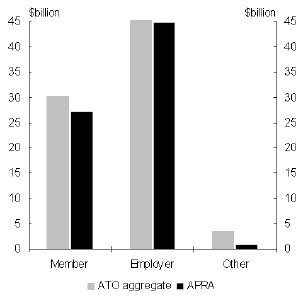Data sources include the 2005-06 Survey of Income and Housing (ABS Cat. No. 6541.0) and the 2005-06 confidentialised Treasury 16 per cent sample (or 1 in 6.25) matched super and personal income tax file, which we re-weight to represent the taxpaying population, adjusting for those who do not lodge returns.
While the ATO and ABS data give a comprehensive view of many of the characteristics of individuals with and without superannuation, there is no single file which captures all characteristics. There is also a lag between economic activity and data collections. So recent changes to superannuation will not yet be apparent from our data. All the data sources have limitations and different data sources often conflict.
The matched super and personal income tax file provides extensive information, such as age, sex, income, deductions, offsets and most of the superannuation items that can be found on the Superannuation Member Contribution Statement (SMCS).
There is significant under representation in superannuation assets (in aggregate) when compared to the equivalent APRA statistics for the same period for both the Treasury confidentialised sample file and the ABS file. For example, superannuation assets in the 2005-06 ABS Income Survey represent around 80 per cent of the comparable APRA assets data (see Chart 1). It should also be noted that the APRA data for the public sector would not include estimates of unfunded liabilities whereas the ABS Income Survey may, in which case there is a large discrepancy between ABS and APRA public sector superannuation assets.
Aggregate superannuation assets data collected by the ATO represents around 56 per cent of average APRA assets for 2005-06 and around 52 per cent of APRA assets at 30 June 2006. It should be noted that responding to the ‘account balance’ question on the SMCS is only required where the fund accepts a Government Co-contribution and where a fund has received a contribution for a member during the year. The combination of these two factors for people in retirement or not working/making contributions mean that the ATO assets data in the sample file (and in aggregate) will not be directly comparable to the APRA data.
Chart 2 shows a high degree of compatibility between the SMCS data and the aggregate APRA statistics between gross employer, member and other contributions to superannuation in 2005-06. In earlier years this has not always been the case.
Chart 1: Aggregate superannuation assets in 2005-06 as a percentage of the average APRA superannuation assets in 2005-061

Chart 2: Aggregate superannuation contributions in 2005-06

Source: Unpublished ATO 2005-06 aggregates, 2005-06 Survey of Income and Housing (ABS Cat. No. 6541.0), HILDA (Wave 6)2 and the Celebrating 10 years of superannuation data collection 1996-2006, APRA’s Insight publication, Issue 2 2007, Special Edition (issued 26 July 2007).
1 Average APRA assets were around $840 billion in 2005-06.
2 This paper uses unit record data from the Household, Income and Labour Dynamics in Australia (HILDA) Survey. The HILDA Project was initiated and is funded by the Australian Government Department of Families, Housing, Community Services and Indigenous Affairs (FaHCSIA) and is managed by the Melbourne Institute of Applied Economic and Social Research (MIAESR). The findings and views reported in this paper, however, are those of the author and should not be attributed to either FaHCSIA or the MIAESR.